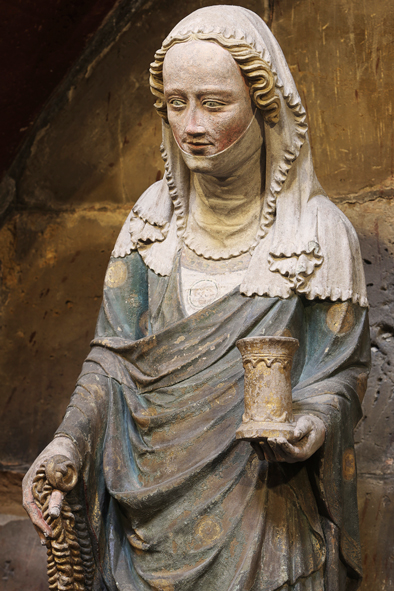|
|
MARY MAGDALENE
Halberstadt, c. 1350
Sandstone, painted
Depicted in elegantly sweeping lines, Mary Magdalene stands with a chrismatory for consecrated oil and a censer for burning incense. Her robes fall in soft folds; signs of a smile render her delicate face enchanting. Since it was last restored, the figure has been presented with its original decorations: her blue mantle is adorned with a pattern of gold roses, the robes beneath are embellished with medallions and the collar with edging. Along with her head covering, her clothing conveys a noble, morally unblemished appearance. In other words, Mary Magdalene is shown here not as the sinner, but as Jesus’ companion, the first to arrive at his grave with her chrismatory and censer, and to learn of the Resurrection. It is not certain what the sculpture was used for; it was probably one of the figures around a Holy Sepulchre for which there are records but which has not survived.
|
|
|
 Primer
Primer
 Anterior
2 a 6 de 6
Siguiente
Anterior
2 a 6 de 6
Siguiente
 Último
Último

|
|
|
 © Kulturstiftung Sachsen-Anhalt, Fotograf: Christoph Jann |
|
|
|
|
MARY MAGDALENE
Halberstadt, c. 1350
Sandstone, painted
Depicted in elegantly sweeping lines, Mary Magdalene stands with a chrismatory for consecrated oil and a censer for burning incense. Her robes fall in soft folds; signs of a smile render her delicate face enchanting. Since it was last restored, the figure has been presented with its original decorations: her blue mantle is adorned with a pattern of gold roses, the robes beneath are embellished with medallions and the collar with edging. Along with her head covering, her clothing conveys a noble, morally unblemished appearance. In other words, Mary Magdalene is shown here not as the sinner, but as Jesus’ companion, the first to arrive at his grave with her chrismatory and censer, and to learn of the Resurrection. It is not certain what the sculpture was used for; it was probably one of the figures around a Holy Sepulchre for which there are records but which has not survived.
© Kulturstiftung Sachsen-Anhalt, Fotograf: Christoph Jann
|
|
|
|
|
THE CATHEDRAL
It is considered one of Germany’s most beautiful church buildings: the Cathedral of St. Stephen and St. Sixtus in Halberstadt. Built entirely in French Gothic style from the 13th to the 15th centuries, it graces the town with its architectural splendour and the variety of its original furnishings. The 290 images on its stained-glass windows, the altar paintings and the many figural groups offer a vivid impression of mediaeval religious beliefs and artistry. Prominent works such as the baptismal font cut from a block of marble, dating to 1195, or the rood with attendant figures from around 1220 testify to the high aspirations of the donors and artists.
The cathedral was an important spiritual hub in Central Germany; the seat of the bishop and members of the chapter, and a destination for mediaeval pilgrims. Its founding dates back to the times of Charlemagne, in the 9th century. In 1591, the members of the chapter did not fully introduce the Reformation, but decided to retain some aspects of the old faith. Until 1810, Protestant and Catholic clerics worked under one roof. This kept the precious mediaeval works of art preserved in the place they were originally used, with no break in the tradition.
Experience a panoramic tour of the cathedral, created by erlebnisland.de and sponsored by Saxony-Anhalt’s tourism association, LTV.
Experience a 360° tour of the cathedral!
© Kulturstiftung Sachsen-Anhalt, Fotograf: Elmar Egner M.A.
|
|
|
|
|
ISLA SAN GIORGIO (VENECIA)=GEORGE LEMAITRE
Just after midday on July 22, 1946, Zionist terrorists, under the leadership of Menachem Begin, set the fuses on bombs planted in the basement of the King David Hotel in Jerusalem. At 12:37 a huge explosion ripped through the building, killing 91 people. Among the dead were 25 Britons, 41 Arabs, and 17 Jews.
|
|
|
 Primer
Primer
 Anterior
2 a 6 de 6
Siguiente
Anterior
2 a 6 de 6
Siguiente
 Último
Último

|

